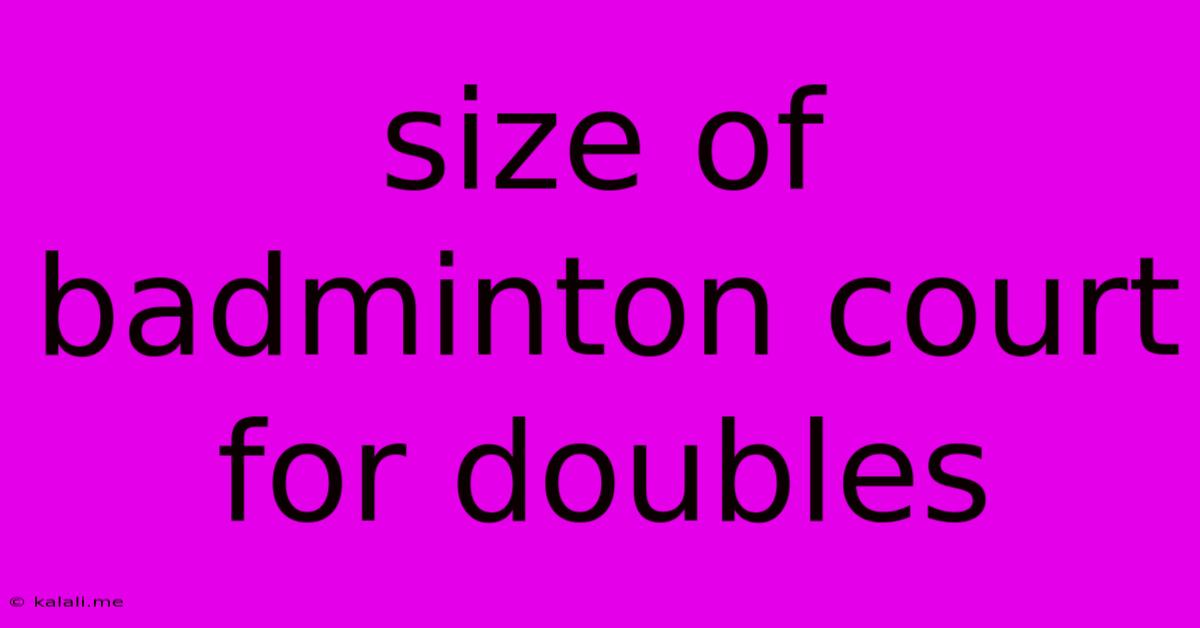Size Of Badminton Court For Doubles
Kalali
Jun 14, 2025 · 3 min read

Table of Contents
Badminton Court Size for Doubles: A Comprehensive Guide
Knowing the precise dimensions of a badminton court is crucial for players of all levels, ensuring fair play and strategic advantage. This guide specifically focuses on the badminton court size for doubles, providing a detailed breakdown of its measurements and highlighting key differences compared to singles. Understanding these dimensions is essential for effective gameplay and mastering court coverage.
The badminton court for doubles is significantly larger than a singles court, offering more space for maneuvering and strategic shot placement. This difference impacts everything from serve positioning to defensive strategies. Let's delve into the specifics:
Dimensions of a Doubles Badminton Court
A standard doubles badminton court is rectangular, measuring 20 feet (6.1 meters) wide and 44 feet (13.4 meters) long. This larger area necessitates a different playing style compared to singles, requiring greater court coverage and strategic positioning of players.
Within this overall area, key areas to understand are:
- Service Area: The service area for doubles is smaller than that of singles, located at the back of each half of the court.
- Long Service Line: This line runs parallel to the net, marking the boundary for the back of the service area.
- Short Service Line: This is closer to the net than the long service line, dividing the service area into sections.
- Center Line: This line divides the entire court into two halves. It's crucial for understanding serving regulations.
- Side Lines: These lines mark the boundaries of the court's width.
- Net: The net is placed centrally across the court, dividing it into two equal playing areas.
Key Differences Between Singles and Doubles Courts
While the doubles court uses the same overall length as the singles court (44 feet / 13.4 meters), its width is increased considerably. The key difference lies in the width:
- Doubles: 20 feet (6.1 meters) wide
- Singles: 17 feet (5.18 meters) wide
This wider court significantly affects gameplay. Doubles necessitates more strategic movement and coordination between partners to cover the larger playing area effectively.
Mastering Court Coverage in Doubles
Efficient court coverage is paramount in doubles badminton. Players need to develop strategies to cover both the front and back of the court effectively. Effective communication and strategic positioning are critical for success. Understanding the dimensions of the doubles badminton court allows players to anticipate shots, cover gaps, and react quicker to opponents' plays.
Beyond Measurements: The Importance of Court Awareness
While knowing the precise dimensions is important, it’s equally vital to develop a strong sense of court awareness. This involves understanding not only the physical boundaries but also anticipating the trajectory of the shuttlecock and the strategic positioning of your opponent. This intuitive understanding of space and movement is crucial for success in doubles badminton.
In conclusion, a solid understanding of the badminton court size for doubles— its length, width, and service areas—is foundational to developing effective doubles strategy. Mastering court coverage, utilizing effective communication with your partner, and developing a keen sense of court awareness are crucial for success in this dynamic and challenging game.
Latest Posts
Latest Posts
-
Which Of The Following Is An Example Of An Autotroph
Jun 15, 2025
-
The Crust And Upper Mantle Together Are Called
Jun 15, 2025
-
Fast Is What Part Of Speech
Jun 15, 2025
-
Difference Between A State And Union Territory
Jun 15, 2025
-
Which Of The Following Compounds Is Not Aromatic
Jun 15, 2025
Related Post
Thank you for visiting our website which covers about Size Of Badminton Court For Doubles . We hope the information provided has been useful to you. Feel free to contact us if you have any questions or need further assistance. See you next time and don't miss to bookmark.